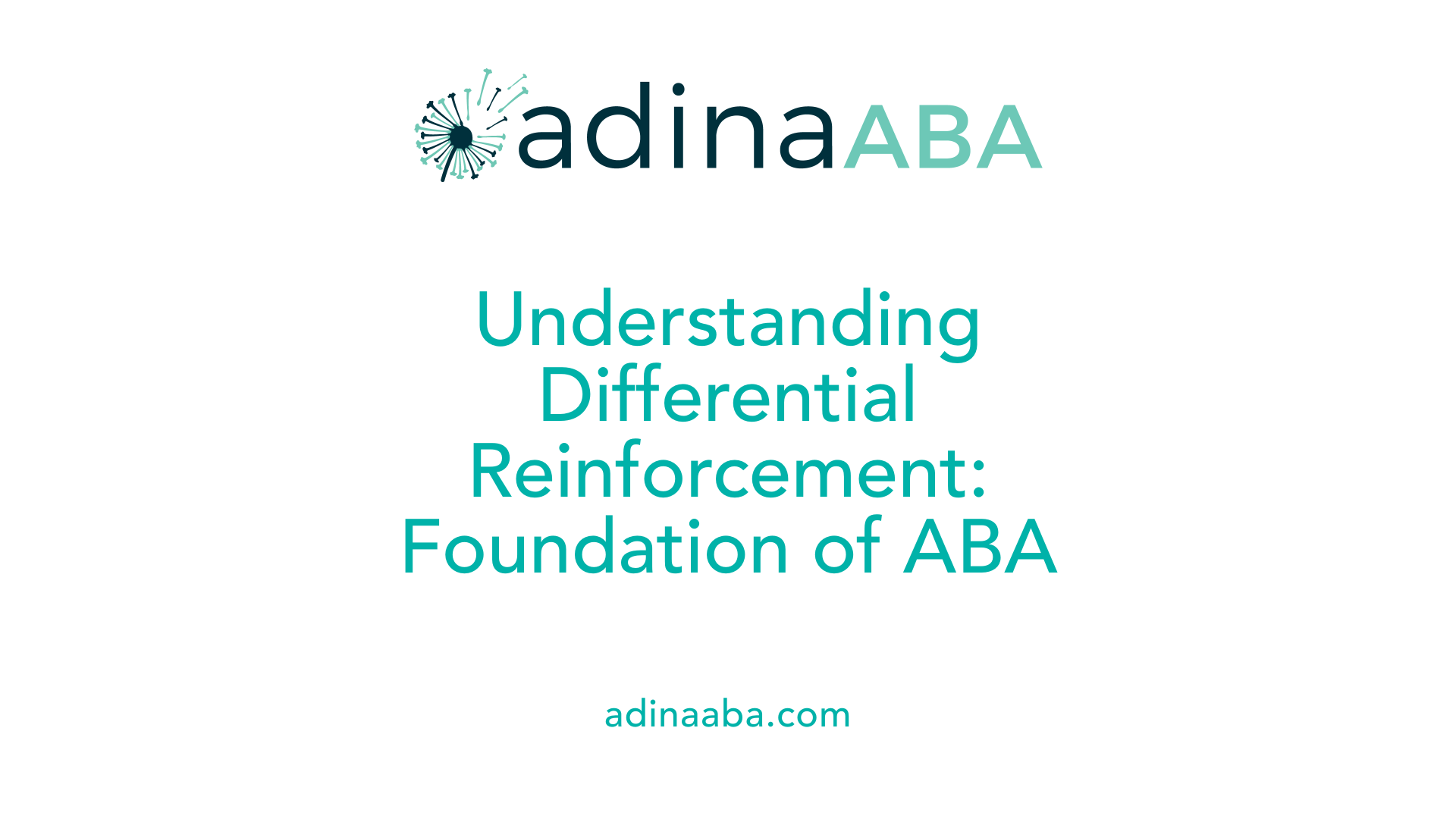What is differential reinforcement and how is it used

Understanding Differential Reinforcement: A Cornerstone of ABA
Differential reinforcement is a fundamental technique within Applied Behavior Analysis (ABA) that focuses on modifying behavior through strategic reinforcement. This approach aims to increase desirable behaviors while decreasing or eliminating undesirable ones, offering a positive and ethical pathway to foster lasting behavioral change across various settings, including therapy, education, and everyday life.
Defining Differential Reinforcement and Its Role in ABA

What is differential reinforcement?
Differential reinforcement is a method used in behavior analysis to encourage desired behaviors and reduce unwanted ones. It works by giving rewards—either adding a pleasant stimulus or removing an unpleasant one—when someone engages in a behavior that is considered appropriate. Conversely, it involves withholding reinforcement or ignoring behaviors that are undesirable. This approach helps individuals learn which behaviors lead to positive outcomes, shaping their responses over time.
The core principle is simple: behaviors that are reinforced tend to increase, while those that are not reinforced or are ignored tend to decrease. This selective process guides individuals toward more adaptive and socially acceptable ways of interacting and responding.
How is it used in behavior analysis and ABA therapy?
In applied behavior analysis (ABA), differential reinforcement plays a crucial role in behavior modification programs. It allows therapists, educators, and parents to target specific behaviors for change with a strategic plan. ABA practitioners initially identify the behaviors that need adjustment and then choose the most suitable differential reinforcement procedure based on the individual’s needs and the behavior's function.
Some of the common types of differential reinforcement used in ABA include:
| Type | Description | Example |
|---|---|---|
| DRA (Differential Reinforcement of Alternative Behavior) | Reinforces a desirable, alternative behavior that serves the same function as the undesired one. | Reinforcing a child’s request politely instead of yelling for a toy. |
| DRI (Differential Reinforcement of Incompatible Behavior) | Reinforces a behavior that cannot occur simultaneously with the problematic behavior. | Reinforcing sitting quietly instead of pacing or fidgeting. |
| DRO (Differential Reinforcement of Other Behavior) | Reinforces any behavior except the target problem behavior during a specific time interval. | Praising a child for not throwing tantrums during a 10-minute window. |
| DRL (Differential Reinforcement of Low Rates) | Reinforces reductions in the frequency of a behavior that is not necessarily inappropriate but occurs too often. | Rewarding a child for washing hands only once before lunch. |
Implementing differential reinforcement involves consistent application, clear behavior definitions, and careful data collection. The goal is to increase behaviors that are beneficial for the individual’s development and social functioning, and decrease behaviors that are disruptive or harmful.
Why is differential reinforcement effective?
This strategy leverages the natural learning process by reinforcing behaviors that are advantageous, thereby increasing their occurrence and importance. It also implicitly teaches individuals about the contingencies of their actions, helping them to make better choices.
Research supports the effectiveness of differential reinforcement in a variety of settings. It is especially useful for reducing challenging behaviors such as aggression, self-injury, or tantrums, while promoting skills like communication, social interaction, and adaptive independence.
In summary, differential reinforcement is a versatile and scientifically supported method that promotes positive behavior change. It is widely used in ABA therapy to support individuals with developmental disabilities, including those on the autism spectrum, as well as in general behavior management contexts. Its success largely depends on precise implementation, ongoing assessment, and the collaboration of caregivers and professionals.
Types of Differential Reinforcement and Their Specific Uses

What are the different types of differential reinforcement and their specific uses?
Differential reinforcement encompasses various strategies primarily aimed at reducing problematic behaviors by encouraging desirable alternatives. Each type of differential reinforcement is tailored to specific behavioral goals, contexts, and individual needs.
Differential Reinforcement of Alternative Behavior (DRA) is frequently used when the goal is to replace an undesirable behavior with a more acceptable one that serves the same function. For example, reinforcing a child's request for a toy instead of grabbing it impulsively helps develop communication skills and reduces disruptive actions.
Differential Reinforcement of Incompatible Behavior (DRI) is applied when a behavior incompatible with the undesired action is reinforced. For instance, praising a child for sitting calmly in their chair instead of fidgeting or leaving helps ensure that the positive behavior prevents the problematic one from occurring at the same time.
Differential Reinforcement of Other Behavior (DRO) involves providing reinforcement for any behavior other than the problematic one within a specific period. For example, ignoring tantrums and praising calm behavior during that interval promotes self-control and reduces the frequency of tantrums.
Differential Reinforcement of Low Rates (DRL) encourages reducing how often a behavior occurs but doesn't necessarily aim for elimination. This is useful for behaviors that are acceptable when infrequent, such as limiting handwashing to a reasonable number of times before lunch.
Differential Reinforcement of High Rates (DRH), although not mentioned in detail here, reinforces behaviors that occur too infrequently, promoting increased responses. For example, encouraging more speech during a conversation.
Choosing the appropriate type depends on understanding the behavior’s function, the context, and whether the goal is to decrease, increase, or regulate the frequency of a specific action. These methods are complemented by consistent implementation, systematic data collection, and active involvement of caregivers or teachers.
Table 1: Summary of Differential Reinforcement Types and Uses
| Type | Purpose | Example | Suitable For |
|---|---|---|---|
| DRA | Reinforce alternative behavior | Requesting politely instead of demanding | Replacing disruptive requests |
| DRI | Reinforce incompatible behavior | Sitting calmly instead of fidgeting | Managing hyperactivity |
| DRO | Reinforce absence of problem behavior | Not tantruming during a specific period | Reducing tantrums |
| DRL | Reduce frequency | Less handwashing before lunch | Excessive repetitive behaviors |
| DRH | Increase response rate | More verbal responses during conversation | Under-socialized behaviors |
Applying these techniques involves defining clear behaviors, understanding their functions, selecting effective reinforcers, and systematically tracking progress. Empirical research supports their effectiveness across different populations, especially children with developmental and behavioral challenges.
Examples of Differential Reinforcement Techniques
 In applied behavior analysis, diverse differential reinforcement methods are used to shape behavior effectively. Each technique targets specific behavioral goals and is selected based on the individual’s needs.
In applied behavior analysis, diverse differential reinforcement methods are used to shape behavior effectively. Each technique targets specific behavioral goals and is selected based on the individual’s needs.
Practical Examples of DRA, DRL, and DRO
Differential Reinforcement of Alternative Behavior (DRA): This technique involves reinforcing a positive alternative to the undesirable behavior. For example, if a child frequently throws objects when seeking attention, a therapist might reinforce the child for raising their hand or using a polite phrase instead of throwing. If a student screams to get out of class, rewarding them for using a calm, raised hand as a request helps replace the screaming with an appropriate communication method.
Differential Reinforcement of Low Rates (DRL): This approach aims to decrease the frequency of a behavior that is not necessarily harmful but occurs excessively. For instance, if a child repeatedly calls out in class, the teacher might reinforce the child for calling out at a slower rate—perhaps only once every ten minutes. Over time, this encourages more controlled and spaced-out calling out.
Differential Reinforcement of Other Behavior (DRO): DRO focuses on reinforcing the absence of the problematic behavior for a certain period. For example, if a child has a habit of leaving their seat frequently, they could receive praise or a small reward when they remain seated without leaving during a ten-minute interval. The focus is on reinforcing any desired activity rather than the problematic one.
Common Behavioral Goals Achieved Through These Techniques
| Technique | Typical Goal | Example Outcome | Setting / Population |
|---|---|---|---|
| DRA | Promote communication and appropriate behaviors | Child asks politely for a break instead of crying | Schools, therapy clinics, home |
| DRL | Reduce overactivity or repetitive behaviors | Child reduces hand-raising to a manageable level | Classrooms, behavioral intervention contexts |
| DRO | Eliminate specific problem behaviors | Child refrains from tantrums during a set time period | Special education, ABA therapy |
Using these methods consistently helps individuals develop better social and communication skills, reduces disruptive behaviors, and fosters independence. The goal across all techniques is to replace challenging behaviors with positive, functional alternatives.
Supporting Behavior Change Without Extinction

How does differential reinforcement support behavior change without the use of extinction?
Differential reinforcement is a strategic approach in applied behavior analysis (ABA) that encourages positive behavior changes by reinforcing desirable actions and withholding reinforcement for undesirable ones. Unlike extinction, which involves completely stopping reinforcement for a problematic behavior—often leading to frustration or escalation—differential reinforcement focuses on promoting alternatives and functional behaviors through positive means.
In practice, this method involves reinforcing behaviors that serve the same purpose as the undesired behavior or are incompatible with it. For example, if a child throws objects when seeking attention, reinforcing their ability to ask politely for attention instead encourages the same goal (getting attention) through a more appropriate behavior.
By consistently rewarding suitable actions, individuals are more likely to repeat these behaviors. This process effectively reduces challenging behaviors without the harsh effects associated with extinction treatments, such as sudden behavior escalation or frustration.
Strategies like Differential Reinforcement of Alternative Behavior (DRA) and Differential Reinforcement of Other Behavior (DRO) exemplify this approach. In DRA, a preferred, appropriate behavior replaces a problematic one, while in DRO, reinforcement is contingent upon the absence of the undesired behavior during specified intervals.
Researchers have demonstrated that these techniques can yield results comparable to extinction, but with fewer negative side effects. For example, providing immediate praise or tangible reinforcers when a child refrains from tantrums or self-injury encourages the emergence of alternative behaviors. Also, using high-quality and timely reinforcement improves motivation and response rates.
Further, combining multiple reinforcement strategies—such as making reinforcement immediate, variable, and highly preferred—boosts learning efficiency. Functional Communication Training (FCT) is another effective approach, teaching children to communicate their needs appropriately, achieving the same outcome as problematic behaviors.
Empirical evidence supports that differential reinforcement not only reduces problem behaviors but also maintains gains over time, as positive behaviors are strengthened through consistent reinforcement. This method fosters a more positive and manageable environment for behavior change, avoiding the potential distress caused by extinction procedures.
In summary, differential reinforcement supports behavior modification by emphasizing positive reinforcement of appropriate behaviors and strategic ignoring or withholding reinforcement for undesirable ones. This approach promotes sustainable change, reduces behavioral escalation, and aligns with ethical practices in behavioral intervention.
Theoretical Foundations and Research Support
How do operant conditioning principles underpin differential reinforcement?
Differential reinforcement is deeply rooted in operant conditioning, a learning theory developed by B.F. Skinner. This principle emphasizes that behaviors which are followed by reinforcement tend to increase in frequency, whereas those that are not reinforced are likely to decrease.
In applied behavior analysis (ABA), this means that by systematically reinforcing desirable behaviors and withholding reinforcement from undesired ones, we can effectively shape behavior over time. For example, reinforcing a child for asking politely (DRA) encourages that behavior to occur more often, while ignoring or not reinforcing disruptive behaviors diminishes their likelihood.
The core concept is that behavior change results from the contingencies between actions and consequences. Reinforcement can be positive (adding a pleasant stimulus) or negative (removing an aversive stimulus), both of which serve to increase the targeted behavior.
What empirical studies support the use of differential reinforcement?
Research in behavior analysis offers robust evidence supporting the effectiveness of differential reinforcement. Many studies focus on the Differential Reinforcement of Alternative Behavior (DRA), demonstrating significant reductions in problem behaviors such as aggression, self-injury, and tantrums.
Empirical data shows that when DRA is combined with extinction procedures—where problem behaviors are no longer reinforced—there’s often a more significant decrease in maladaptive behaviors. Experimental procedures typically involve manipulating reinforcement parameters like the schedule of reinforcement, the quality of reinforcement (preference), and the timing to observe their effects on behavior.
Several experimental studies have affirmed that adjusting these variables leads to optimal behavior change. For example, research supported by the matching law indicates that response allocation shifts based on reinforcement rate and quality, reinforcing the idea that behavior is sensitive to reinforcement schedules.
Clinical applications of differential reinforcement in treating autism and other developmental disorders have been extensively documented, proving its validity and reliability. Studies consistently report improvements in social, communicative, and adaptive skills when differential reinforcement techniques are applied correctly.
Overall, the theoretical framework from operant conditioning combined with rigorous experimental research provides a solid foundation for the widespread use of differential reinforcement. These studies not only validate its efficacy but also guide practitioners in optimizing intervention strategies for meaningful and lasting behavior change.
Implementing Differential Reinforcement: Steps and Considerations
What are the steps to implement differential reinforcement effectively?
Implementing differential reinforcement (DR) involves a systematic approach to ensure its success and sustainability. The process begins with clearly defining the target behaviors. These should be specific, observable, and measurable to accurately monitor progress.
The next step is conducting thorough assessments, such as a Functional Behavior Assessment (FBA). This helps understand the reasons behind a behavior—its function—and guides the selection of appropriate reinforcers and intervention strategies.
Based on assessment findings, practitioners choose the suitable type of DR procedure. For instance, if the goal is to replace a challenging behavior with a more appropriate one, Differential Reinforcement of Alternative Behavior (DRA) might be appropriate. Conversely, if reducing the frequency of a behavior is the aim, Differential Reinforcement of Lower Rates (DRL) could be selected.
Once the procedure is chosen, setting clear, measurable criteria for reinforcement is essential. These criteria determine when reinforcement will be delivered—such as a specific number of appropriate responses or the absence of undesired behavior over a set time.
Establishing an appropriate reinforcement schedule is crucial for maintaining motivation and ensuring gradual behavior change. Schedules like fixed ratio or variable interval can be used depending on the context and individual needs.
Consistent application of the plan is vital. This includes training all involved parties—parents, teachers, therapists—to implement procedures uniformly. Ongoing data collection allows for monitoring behavior trends and assessing intervention effectiveness.
Data should be reviewed regularly, with adjustments made as needed to optimize outcomes. Flexibility in modifying reinforcement criteria or schedules in response to progress supports long-term success.
Finally, collaboration with caregivers, educators, or other stakeholders enhances consistency across environments. Clear communication and reinforcement of the protocol help sustain behavior changes and foster generalization.
Adherence to these steps, combined with patience and individualization, maximizes the effectiveness of differential reinforcement interventions and promotes lasting positive behaviors.
Benefits and Practical Applications of Differential Reinforcement
What are the benefits of differential reinforcement and where is it applied?
Differential reinforcement offers numerous advantages in behavior management and skill development. It effectively fosters positive behavioral changes by encouraging desirable actions while reducing problematic behaviors such as aggression, self-injury, or disruptive outbursts.
One of its primary benefits is facilitating the acquisition of new skills. For example, children can learn to ask politely instead of demanding, or remain seated instead of leaving their posts voluntarily. This technique is especially useful in guiding individuals toward greater independence and improved social interactions.
Furthermore, differential reinforcement is adaptable to various populations and settings. It is commonly used with children who have developmental disabilities like autism spectrum disorder, but also in educational environments, workplaces, and clinical settings for adults requiring behavior support.
Its applications are diverse and include behavior management in classrooms, therapy sessions, and home routines. For instance, teachers may reinforce students for participating actively in class, or therapists might encourage communication skills or self-care routines.
In the long run, consistent use of differential reinforcement can produce lasting behavior change. Over time, individuals tend to generalize and sustain these positive behaviors across different settings, contributing to a better quality of life.
This method also enhances safety, as challenging behaviors decrease, reducing risk for harm. It promotes a supportive environment where individuals learn appropriate responses aligned with social expectations.
Overall, differential reinforcement is valued for its ethical, evidence-based approach to behavior modification, offering sustainable benefits that extend beyond immediate changes to promote overall well-being and functional independence.
Conclusion: Embedding Differential Reinforcement in Behavior Management
What is the purpose and principle behind differential reinforcement?
Differential reinforcement is a behavior management strategy rooted in operant conditioning principles. Its main purpose is to promote positive, functional behaviors while reducing maladaptive or problematic responses. The core idea is to reinforce behaviors that are desirable and serve the individual's needs, and to withhold reinforcement for behaviors that are undesirable.
This method involves systematically applying reinforcement — either positive (adding a pleasant stimulus) or negative (removing an aversive stimulus) — to encourage specific responses. For instance, when a child politely asks for a toy instead of grabbing it, positive reinforcement such as praise or a small reward can strengthen that polite behavior. Conversely, behaviors like tantrums are ignored or not reinforced, which over time reduces their occurrence.
The principle pivots on selectively reinforcing targeted responses and using extinction, which is the withholding of reinforcement, to diminish problematic behaviors. This can be implemented through various types of differential reinforcement, such as DRA (reinforcing alternative behaviors), DRI (reinforcing incompatible behaviors), or DRO (reinforcing the absence of undesired behavior during set intervals).
Overall, differential reinforcement is designed to facilitate behavior change by shaping response patterns through consistent and individualized reinforcement. It is a research-supported and ethically sound approach that encourages learning and adaptation across diverse settings, from classrooms to clinical environments and home routines.
Bringing It All Together: The Future of Differential Reinforcement in Behavior Change
In summary, differential reinforcement stands as a robust, evidence-based technique that enables practitioners and caregivers to guide behavior change ethically and effectively. Its versatile application across a wide range of behaviors and populations underscores its importance in promoting social, emotional, and functional development. The success of differential reinforcement hinges on systematic implementation, consistent application, and thoughtful individualization to meet each person's unique needs. Ongoing research continues to refine its methods and expand its applicability, ensuring that it remains a cornerstone strategy in behavior analysis. As understanding and techniques evolve, differential reinforcement will undoubtedly play a vital role in fostering positive, sustainable behavior change in diverse settings, empowering individuals to reach their full potential.
References
- What Is Differential Reinforcement in Applied Behavior Analysis?
- Differential Reinforcement: A Complete Guide - Master ABA
- Differential Reinforcement ABA Strategies
- Page 8: Differential Reinforcement of Alternative Behavior
- Differential Reinforcement | Definition, Theory & Types - Lesson
- How Differential Reinforcement ABA Works in Behavior Change
- Differential Reinforcement | EBIP - VKCSites.org
More Resources
Expert Clinicians
Get started today ->




.jpg)
.jpg)
